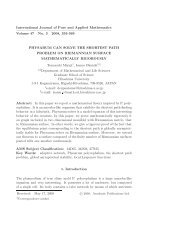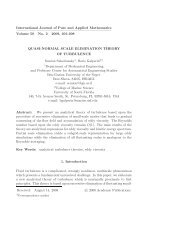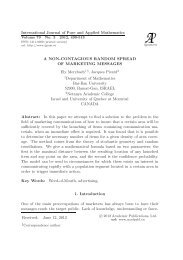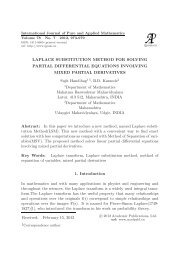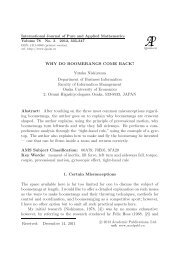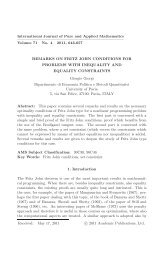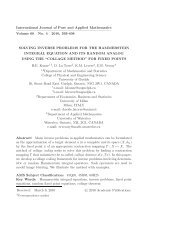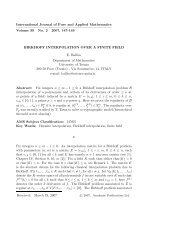FINDING N-TH ROOTS IN NILPOTENT GROUPS AND ...
FINDING N-TH ROOTS IN NILPOTENT GROUPS AND ...
FINDING N-TH ROOTS IN NILPOTENT GROUPS AND ...
You also want an ePaper? Increase the reach of your titles
YUMPU automatically turns print PDFs into web optimized ePapers that Google loves.
<strong>F<strong>IN</strong>D<strong>IN</strong>G</strong> N-<strong>TH</strong> <strong>ROOTS</strong> <strong>IN</strong> <strong>NILPOTENT</strong> <strong>GROUPS</strong>... 583<br />
Definition 5.8. Let G be nilpotent of class 2. Define M(G) = {g ∈<br />
G|g = g1g2 · · · gn, where each factor gi ∈ G occurs an even number of times,<br />
with occurrences of g −1<br />
i counted together with occurrences of gi}.<br />
Clearly, M = M(G) is a normal subgroup of G.<br />
Lemma 5.9. G/M is an elementary Abelian two-group.<br />
Proof. If gM ∈ G/M, then (gM) 2 = g 2 M = M.<br />
Lemma 5.10. Let CG(Q) = {g ∈ G|gq = qg,q ∈ Q} (that is, CG(Q) is<br />
the centralizer in G of Q). Then M ≤ CG(Q).<br />
Proof. Let q ∈ Q and m = g1g2 · · · gn ∈ M. Then<br />
[q,m] = [q,g1g2 · · · gn] = [q,g1][q,g2] · · · [q,gn],<br />
where distinct g ′ is occur an even number of times. Since G is nilpotent of class<br />
two, each [q,gi] ∈ Z(G). By Lemma 5.7, [q,gi] 2 = 1. Hence, [q,m] = 1.<br />
This last lemma implies that no element of the perfect square root X of G<br />
is contained in M. For if it is, an element of X would commute with Q ∩ X<br />
(which is nonempty by Lemma 5.4), contradicting the fact that no two elements<br />
of X commutes.<br />
Theorem 5.11. If G is nilpotent of class 2, then G has no perfect square<br />
root.<br />
Proof. We will prove by contradiction. Suppose that G is nilpotent of class<br />
2 and that X is a perfect square root of G. Let M be as defined above. We will<br />
denote the image of X in G/M by X. Further, we will consider X as a multiset<br />
instead of a set, since distinct elements of X may be mapped to same cosets<br />
of M. We will look at the occurrences of elements of M in the multiplication<br />
table of X by finding a bound for occurrences of 1 ∈ G/M in the multiplication<br />
table for X.<br />
Let the distinct elements of X be a0, a1, ..., ak−1, so that there are k<br />
distinct cosets of M in X. Let |X| = |X| = n = kq + r, where 0 ≤ r < k. List<br />
the elements of the multiset X as b0,b1,... ,bn−1 as follows:<br />
• Let b0 = a0.<br />
• Suppose bi = aj. Then let<br />
bi+1 =<br />
aj+1 if j < k − 1<br />
a0 if j = k − 1



